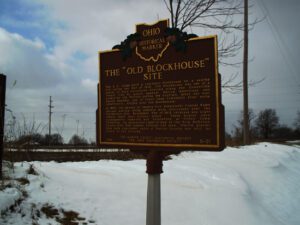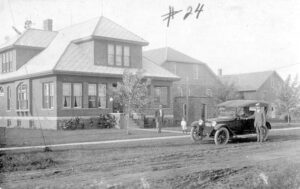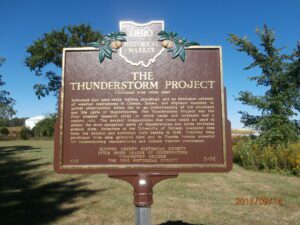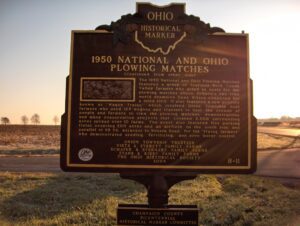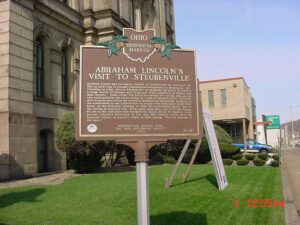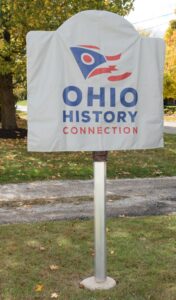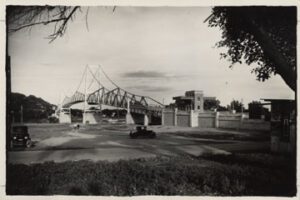, OH
In 1968, Richard Nixon won the presidency partly based on a campaign promise to end the Vietnam War. Though the war seemed to be winding down, on April 30, 1970, Nixon announced the invasion of Cambodia, triggering protests across college campuses. On Friday, May 1, an anti-war rally was held on the Commons at Kent State University. Protestors called for another rally to be held on Monday, May 4. Disturbances in downtown Kent that night caused city officials to ask Governor James Rhodes to send the Ohio National Guard to maintain order. Troops put on alert Saturday afternoon were called to campus Saturday evening after an ROTC building was set on fire. Sunday morning in a press conference that was also broadcast to the troops on campus, Rhodes vowed to “eradicate the problem” of protests at Kent State. (Continued on other side)
, OH
The U.S. Army built a two-story blockhouse on a nearby hill during the War of 1812. The blockhouse was one of a series of such structures erected along the Greenville Treaty line to guard against Native Americans who supported the British during the conflict. After the war, Daniel Markley, one of Green Camp Township’s first white inhabitants, settled near the blockhouse. In 1963, the graves of twenty-five prehistoric Glacial Kame Indians and six white settlers were discovered near the blockhouse site. Seventeen War of 1812 veterans and eight others were also buried there. These bodies were subsequently removed and reinterred at Green Camp Cemetery. An abandoned right-of-way of the Erie Railroad, Dayton line, also passes through the area. Prairie grasses that once dominated parts of Marion County can still be found in the vicinity.
, OH
Nicknamed “Dutchtown” for the many German families that settled in this area, New Washington was platted in 1833 by George Washington Meyers, who arrived in Cranberry Township in 1826. Prominent Austrian romantic poet Nicholas Lenau (1802-1850), author of “Faust” and “Don Juan,” owned property here in the 1830s. The village incorporated in 1874, shortly following the arrival of the Mansfield, Coldwater & Lake Erie Railroad. New Washington is a pioneer in the commercial poultry hatchery industry and initiated the shipment of baby chicks by rail in 1900.
, OH
Before and during World War II, the aviation industry was vulnerable to adverse weather conditions, particularly thunderstorms. In 1945, Congress mandated the nation’s first large-scale, scientific study of thunderstorms. The Thunderstorm Project was a cooperative undertaking of the U.S. Weather Bureau, Army Air Force, Navy, and the National Advisory Committee for Aeronautics (predecessor of NASA). The first phase of the project was conducted in Florida in 1946 and the second phase in Clinton County in 1947, partly because weather fronts frequently pass through this area. Pilots from the Clinton County Army Air Force Base made many flights through storms of varying intensities and all stages of development. (Continued on other side)
, OH
Benson Road and the North Urbana Lisbon Road (SR 54) in Champaign County was the site of the 1950 National and Ohio Plowing Matches and the National Association of Soil Conservation Districts Field Days. The three-day event drew a crowd of nearly 75,000 and was headquartered in the woods of the Edwin (Ned) Kirby farm located a quarter mile north on Benson Road. The National Association of Soil Conservation Districts sponsored the National and Ohio Plowing Matches. The first national matches were held in Mitchellville, Iowa in 1939 and continued until halted by the start of World War II. They resumed in 1945. Ohio’s 1950 Champaign County-Union Township National Plowing Matches was the first “National” to be held outside Iowa. (continued on other side)
, OH
Abraham Lincoln and his family stopped in Steubenville on February 14, 1861 on their way to Lincoln’s presidential inauguration in Washington, D.C. Traveling by train, once in Steubenville he departed the depot to address a large crowd of Ohioans and Virginians from a platform at Market and High Streets. When Judge W.R. Lloyd introduced him as the only person who could preserve the Union during this time of national crisis, President elect Lincoln electrified the attentive audience by eloquently speaking on the commitment to the Constitution by people from both sides of the Ohio River, on the differing opinions of what the Constitution means, and on the virtues of majority rule. Fifty-seven days later, the Civil War began. No one at the time knew that Steubenville native Edwin M. Stanton would become Lincoln’s Secretary of War and that Stanton would give the immortal tribute at Lincoln’s death in 1865 saying, “Now he belongs to the ages!”
, OH
Archibald Worthington (1818-1895) was a freed slave from Virginia, a Civil War veteran, and prominent landowner in Highland Township. Census records indicate he was manumitted prior to 1850, and by 1860 owned land in northwest Ohio. Worthington also farmed, boarded freed slaves, and owned apple orchards and livestock. April 1866 township records show that he supported the local school for Black families. He and his wife Elizabeth raised three children: Henry, Mathilda, and James. Henry enlisted in the Massachusetts 54th Volunteer infantry, one of the first Black regiments formed in the Civil War. He died January 8, 1865, in a prison camp and is buried in North Carolina’s Salisbury National Cemetery. Mathilda and James both met partners and married, had children, and left the area. Archibald Worthington died in 1895 and is buried in Wilmington’s Sugar Grove Cemetery.
, OH
On December 15, 1967, about one mile downstream from this historic marker, a national tragedy occurred. Forty-six interstate travelers lost their lives when the Silver Bridge collapsed into the Ohio River during five o’clock rush hour traffic. The 2,235 foot two-way vehicular bridge connected Point Pleasant, West Virginia and Kanauga, Ohio via U.S. Route 35. The West Virginia Ohio River Company built the structure in 1928 for $1.2 million. The bridge, unique in its engineering conception, was the first of its design in America and the second in the world. Instead of woven-wire cable, the bridge was suspended on heat-treated eye-bar chains. It was named the “Silver Bridge” because it was the first in the world to be painted with aluminum paint. In 1969, two years later, its replacement, the Silver Memorial Bridge was dedicated.



